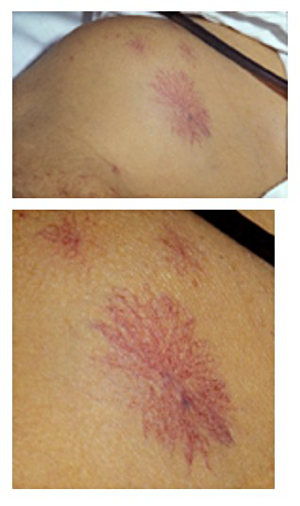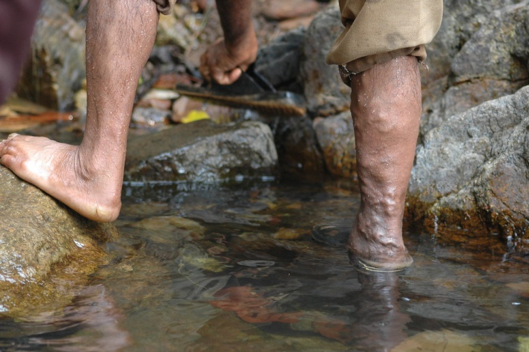When is vein removal required to treat a venous condition? Many people struggling with varicose veins complain about the discomfort and pain they experience. The aching and cramping occur in the legs (where the veins normally emerge). A few other symptoms that many people with spider and varicose veins experience are as follows:
- Burning sensation
- Throbbing
- Heaviness in legs
- Tiredness
- Restlessness (often due to pain in the legs)
- Tingling
Moreover, another common symptom that many people with damaged veins observe is they feel relieved once they elevate their legs. Many of them experience pain relief due to support hose and support stockings.

(Source)
In women, the damaged veins’ condition can worsen due to their menstrual periods and pregnancy. Ulcers and swelling around the damaged vein area are also common symptoms. All in all, damaged veins can pose significant health risks and deteriorate the circulatory system leading to other health conditions.
What Are Spider Veins?
Spider veins are tiny damaged veins that may appear as blue, red, or purple in color. People often go for cosmetic vein treatments to get rid of the unpleasant appearance of web-like and sunburst emergence of small veins on their skins.
Commonly, spider veins occur on the face or legs but can appear on other parts of the body as well.
What Are Varicose Veins?
Varicose veins are dissimilar to spider veins in terms of enlargement, swelling, and the twisted patterns they form. Moreover, they may also appear as dark blue, purple, or green on the skin. They occur when the valves in the veins are no longer able to function adequately. It leads to the accumulation and pooling of blood trying to flow in the correct direction.
According to data, on average, one in every 4 US adults develops varicose veins. Furthermore, nearly 23 percent of adults might also experience varicose veins at some point in their lifetime.
What Causes Varicose and Spider Veins?
There are some possible factors that make you prone to varicose and spider veins. Some of them include:
- Hereditary diseases
- Obesity
- Birth control pills usage
- Hormonal stress due to menopause, puberty, and pregnancy
- Hormonal Replacement (postmenopausal)
- Extended standing
- Trauma to the skin
- Injury or physical damage to the skin
- Blood clot health condition history
- Increase in abdominal pressure due to conditions like constipation
- Extra-tight garments and clothing around the body parts
What Are the Risk Factors for Varicose and Spider Veins?
Experts suggest certain factors increase the risk of varicose and spider veins in the body. Below are some of those risk factors:
- Pregnancy
- Genetics (data)
- Old age (veins weaken)
- Hormonal influence and pressure
- Prolonged standing or sitting (even as an occupational activity)
- Being female (data)
- History of blood clots or similar conditions
- Overweight and obesity
When Does A Vein Need To Be Removed?
Normally, when people see varicose or spider veins on their skin, they use home treatments. Home remedies are not at all invasive and promote better health. However, there is little evidence of how home treatments can help make the varicose veins disappear or fade away.
Here are some of the home treatment options that may help to remove damaged veins in the body:
- Compression hoses or stockings
- Exercise
- Weight control
- Diet planning
- Elevating legs when there is a chance
Regardless, if the pain and other discomforting symptoms do exist or you want to get rid of the appearance of the damaged veins, removal and closure surgeries are some options.
Vein Removal: Treatments and Surgical Procedures
Treatments and surgical procedures for damaged veins can help to restore function and enable healthy blood flow by closing, sealing, or completely removing them.
Moreover, the surgical procedures range from minimal to moderate invasion into the body. Here are some of the treatment methods that vascular surgeons use for damaged vein treatment.

(Source)
Surgery
Varicose veins are larger and swollen veins that do not fade easily or may take time before they disappear after non-invasive procedures. Therefore, you can choose to go for the ligation and stripping procedure.
The vascular surgeon uses numbing agents on the affected area and then removes the varicose veins from the damaged blood vessel network. They may tie the ends and remove only the damaged part of a vein. In addition, you might require stitches in the end.
Non-Invasive Procedures
Your surgeon does not need to shift you to the Operation Theater for these non-invasive procedures. They can easily take place in a general doctor’s clinic or lab.
- External Laser Therapy: to close and seal off small veins that are present near the surface of the skin using laser.
- Sclerotherapy: to damage the inside of the vein, which creates scar tissue leading to the closure of the vein.
- Laser Ablation Therapy: involves passing radiation beam through a small fiber wire to heat the veins without making incisions. The vein experiences damage that leads to the closure of the skin.
Vein Removal: Conclusion
Do you want to treat your damaged vein to alleviate pain or improve your aesthetic condition through the most effective treatment? The Vascular Surgery & Vein Center can provide you with the best treatments and care.
Dr. Norman Chideckel, MD, is a highly experienced vascular surgeon will consult with you about your venous condition and suggest the best vein removal options. Give us a call at 212-993-6133 to schedule a meeting today.
Visit our official website to learn more.


